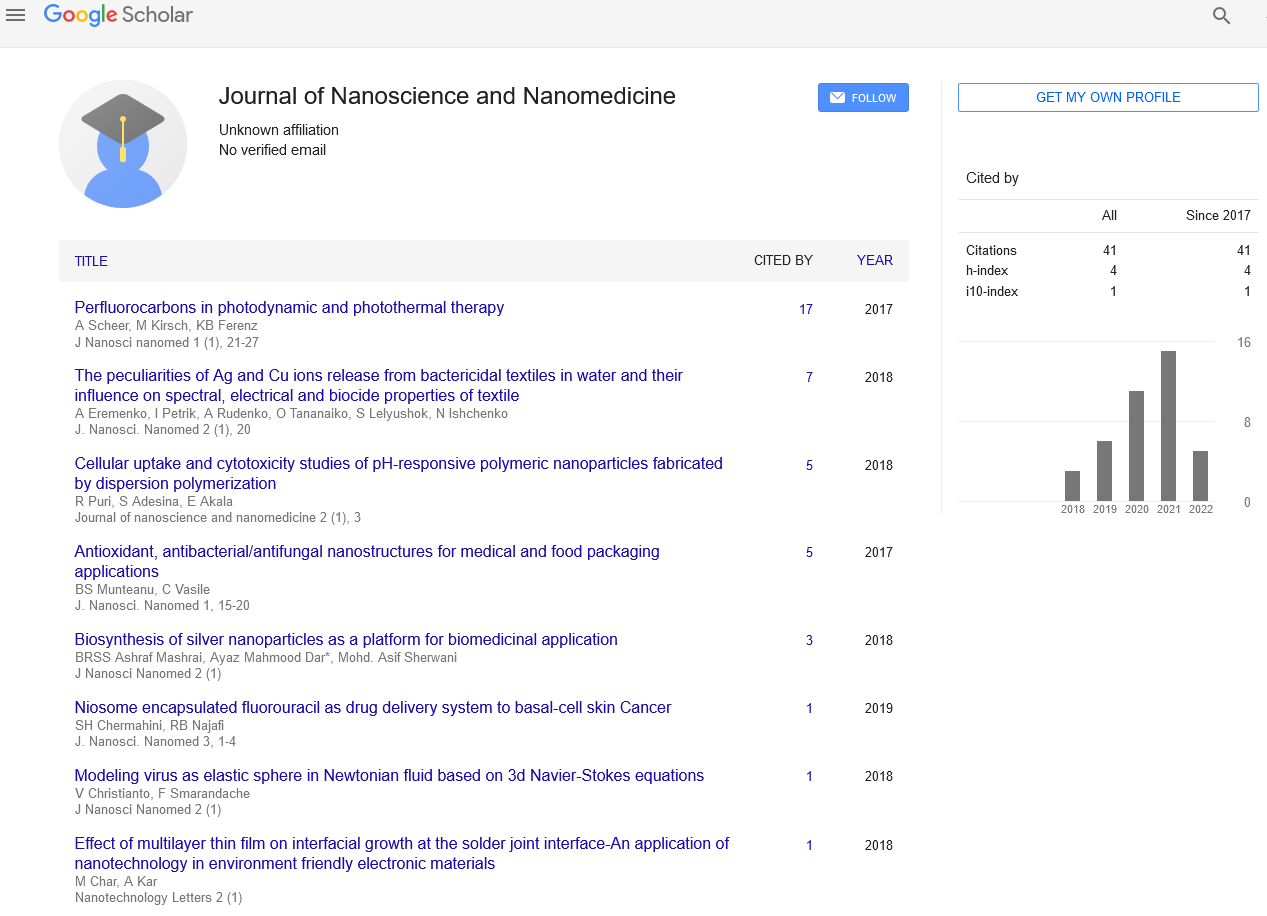Nano scale Modeling and Simulations
Received: 03-Mar-2021 Accepted Date: Mar 15, 2021; Published: 23-Mar-2021
Citation: Antony M. Nano scale Modeling and Simulations. J Nanosci Nanomed 2021;5(2):2.
This open-access article is distributed under the terms of the Creative Commons Attribution Non-Commercial License (CC BY-NC) (http://creativecommons.org/licenses/by-nc/4.0/), which permits reuse, distribution and reproduction of the article, provided that the original work is properly cited and the reuse is restricted to noncommercial purposes. For commercial reuse, contact reprints@pulsus.com
Abstract
Modeling and simulation at Nano scale and nanostructures gives an empowering computational magnifying lens that pictures, and examinations upgrading the understanding at such moo length scales. Later modeling and recreation applications from our inquire about for understanding fabric intelligent, interfacing, distortion and disappointment; property expectations of pertinence to polymeric composites; cementitious materials, nanoscale layered metallic composites, bio frameworks and biosensor applications to fortify inquire about motivation.
Keywords
Modeling, Simulation, Nanoscale, Fabric intelligent, Polymeric composites.
Introduction
Modeling and simulation is the utilize of models (e.g., physical, numerical, or coherent representation of a framework, substance, marvel, or prepare) as a premise for reenactments to create information utilized for administrative or specialized choice making. Modeling and Recreation Building is making a concept, plan or theory and testing it in real-world conditions through: Graphical and Scientific Models, Virtual Reality Recreations, Material science Based Genuine Gaming, Computer Programming, 3-D Printed Models, and Measurable Examination. Their estimate and optical properties can be put to commonsense utilize: nanoscale gold particles specifically amass in tumors, where they can empower both exact imaging and focused on laser pulverization of the tumor by implies that dodge hurting solid cells [1].
Simulation modeling fathoms real-world issues securely and proficiently. It gives an critical strategy of examination which is effectively confirmed, communicated, and caught on. Over businesses and disciplines, recreation modeling gives important arrangements by giving clear bits of knowledge into complex frameworks [2]. Modeling of memristor has been carried out mulling over the temperature impact on its different parameters. A relationship is set up between temperature and portability, based on the temperature subordinate conductivity. Conventional recollections; Energetic Slam, Inactive Smash, and Streak are depending on charge for data capacity, presently confront physical confinements of scaling, moo thickness, and revive overhead like challenges.
Molecular dynamics (MD) reenactment could be a capable apparatus to examine the nan scale liquid stream. In this article, we audit the strategies and the applications of MD reenactment in fluid streams in nan channels. For pressure-driven streams, we center on the basic investigate and the levelheadedness of the show speculations. For electro kinetic-driven streams and the thermal-driven streams, we concentrate on the rule of creating fluid movement [3]. The slip boundary condition is one of the stamped contrasts between the large scale- and micro-scale streams and the Nano scale streams. In this article, we audit the parameters controlling the degree of boundary slip and the unused discoveries. MD reenactment is based on the Newton's moment law to reenact the particles' intuitive and comprises of a few critical handling strategies, such as the warm divider show, the cut-off span, and the beginning condition.
Atomic elements reenactments give a computational apparatus to test layer proteins and frameworks at length scales extending from nanometers to shut to a micrometer, and on microsecond timescales [3]. All particle and coarse-grained recreations may be utilized to investigate in detail the intelligent of film proteins and particular lipids, yielding expectations of lipid official destinations in great assertion with accessible basic information. Building on the victory of protein–lipid interaction reenactments [4], bigger scale reenactments uncover swarming and clustering of proteins, coming about in moderate and bizarre diffusional flow, inside reasonable models of cell films. Current strategies permit close nuclear determination reenactments of little film organelles, and of wrapped infections to be performed, uncovering key angles of their structure and practically critical flow.
Molecular dynamics (MD) and related atomic recreation approaches give important instruments which permit us to recreate both individual membrane proteins and more complex film systems [5]. Hence, MD reenactments have gotten to be a valuable addition to the run of test basic and biophysical strategies for considering film proteins and their intuitive with lipids. Utilizing multiscale atomic recreations as a ‘computational microscope’ able to characterize the intuitive of membrane proteins with lipid, coordinating, incorporating and amplifying the data which may be obtained from exploratory auxiliary and biophysical studies.
Conclusion
Recreation approaches have been amplified to allow swarmed and complex films to be simulated with expanding organic authenticity. Having in this way established the exactness and utility of computational approaches to cell layers, they are presently being used to demonstrate and recreate cellular organelles and enveloped viruses.
REFERENCES
- Nguyen HPT, Arafin S, Piao J et al. Nanostructured Optoelectronics: Materials and Devices. J Nano mat. 2016.1-4.
- Jain A, Sharma SK, Raj B. Design and analysis of high sensitivity photosensor using cylindrical surrounding gate MOSFET for low power applications.Eng. Sci Technol Int J. 2016;19(4):1864-1870.
- Grierson, David S. Nanotribological properties of nanostructured hard carbon thin films. 2008.
- Khoei AR, Ghahremani P. Temperature-dependent multi-scale modeling of surface effects on nano-materials. Mech Mat. 2012;46: 94-112.
- Yuxiu Li, Jinliang Xu, Dongqing Li. Molecular dynamics simulation of nanoscale liquid flows. Microfluidics Nanofluidics. 2010;9:1011–1031.





